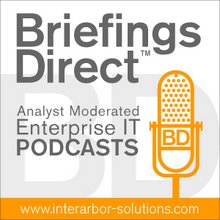This guest post comes courtesy of Tony Baer's OnStrategies blog. Tony is senior analyst at Ovum.Informatica is within a year or two of becoming a $1 billion company, and the CEO’s stretch goal is to get to $3b.
Informatica has been on a decent tear. It’s had a string of roughly 30 consecutive growth quarters,

growth over the last 6 years averaging 20%, and
2011 revenues nearing $800 million.
Abbasi took charge back in 2004, lifting Informatica out of its midlife crisis by ditching an abortive foray into
analytic applications, instead expanding from the company’s
data transformation roots to
data integration.
Getting the company to its current level came largely through a series of acquisitions that then expanded the category of data integration itself. While
master data management (MDM) has been the headliner, other recent acquisitions have targeted
information lifecycle management (ILM),
complex event processing (CEP), low latency messaging (ultra messaging), along with filling gaps in its
B2B and
data quality offerings. While some of those pieces were obvious additions, others such as ultra messaging or event processing were not.
CEO
Sohaib Abbassi is talking about a stretch goal of $3 billion revenue. The obvious chunk is to deepen the company’s share of existing customer wallets. We’re not at liberty to say how much, but Informatica had a significant number of 6-figure deals. Getting more $1m+ deals will help, but on their own won’t triple revenue.
So how to get to $3 billion?
Obviously, two strategies: deepen the existing business while taking the original formula to expand the footprint of what’s data integration.
First, the existing business. Of the current portfolio, MDM is likely best primed to allow Informatica to more deeply penetrate the installed base. Most of its data integration clients haven’t yet done MDM, and it is not a trivial investment. And for MDM clients who may have started with a customer or product domain, there are always more domains to tackle. During Q&A, Abbasi listed MDM has having as much potential addressable market as the traditional
ETL and data quality segments.
The addition of SAP and Oracle veteran
Dennis Moore to the Informatica MDM team points to the classic tightrope f
or any middleware vendor that claims it’s not in the applications game – build more “solutions” or jumpstart templates to confront the same generic barrier that packaged applications software was designed to surmount: provide customers an alternative to raw toolsets or custom programming. For MDM, think industry-specific “solutions” like counter-party risk, or horizontal patterns like social media profiles. If you’re Informatica, don’t think
analytic applications.
That’s part of a perennial debate (or rant) on whether
middleware is the new enterprise application: you implement for a specific business purpose as opposed to technology project, such as application or data integration, and you implement with a product that offers patterns of varying granularity as a starting point.
This prompts the question, just because you can do it, should you.
Informatica MDM product marketing director Ravi Shankar argues it’s not an application because applications have specific data models and logic that become their own de factor silos, whereas MDM solutions reuse the same core
metadata engine for different domains (e.g., customer, product, operational process). Our contention? If it solves a business problem and it’s more than a raw programming toolkit, it’s a de facto application. If anybody else cares about this debate, raise your hand.
MDM is typically a very dry subject but demo’ing a
social MDM straw man showing a commerce application integrated into
Facebook perked
Twitter debate among analysts in the room. The operable notion is that such a use of MDM could update the customer’s (some might say, victim’s) profile by the associations that they make in social networks. An existing Informatica higher educational client that shall remain anonymous actually used MDM to mine
LinkedIn to prove that its grads got jobs.
This prompts the question, just because you can do it, should you. When a merchant knows just a bit too much about you – and your friends (who may not have necessarily opted in) – that more than borders on creepy. Informatica’s Facebook MDM integration was quite effective; as a pattern for social business, well, we’ll see.
Staking new ground
So what about staking new ground? When questioned, Abbasi stated that Informatica had barely scratched the surface with productizing around several megatrend areas that it sees impacting its market:
cloud,
social media,
mobile, and
big data. More specifically:
What, no exit talk?
Abbasi commented at the end of the company’s annual IT analyst meeting that this was the first time in recent memory that none of the analysts asked who would buy Informatica when. Buttonholing him after the session, we got his take which, very loosely translated to
Survivor terms, Informatica has avoided getting voted off the island.
At this point, Informatica’s main rivals –
Oracle and
IBM – have bulked up their data integration offerings to the point where an Informatica acquisition would no longer be gap filling; it would simply be a strategy of taking out a competitor – and with Informatica’s growth, an expensive one at that.
One could then point to dark horses like
EMC,
Tibco,
Teradata, or
SAP (for obvious reasons we’ve omitted
HP). A case might be made for EMC, or SAP if it remains serious in raising its profile as database player– but we believe both have bigger fish to fry. Never say never. But otherwise, the common thread is that data integration will not differentiate these players and therefore it is not strategic to their growth plans.
This guest post comes courtesy of Tony Baer's OnStrategies blog. Tony is senior analyst at Ovum.You may also be interested in:






